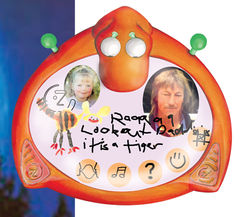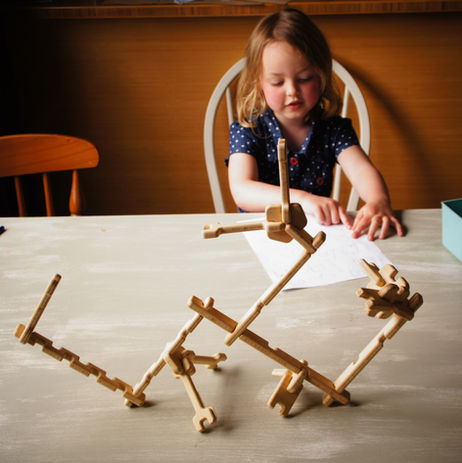Build-it - Kids Building System to aid engineering learning through play
 1 |  2 |  Prototype Clips |
|---|---|---|
 Concept sketches |  Prototype testing Clip 1 |  Prototype testing Clip 2This clip is designed for 45degree angled attachment - for bracing. |
 Version 3Clip 3 can be attached anywhere, doesn't need to be near an end, slide on, flip over the second stake and fix with rubber band. |  Build testingProto-play |  Testing Clip2 |
 No product conceptIdea to try fixing with recycled bike tubing |  Prototyping playMy youngest 2 kids helped me build a fort. |  Fort building |
 Happy campers |
An exploration in engineering play. Play to learn.
Kids are incredibly creative. If you give kids the tools, a challenge, freedom and support, kids can design and build anything. This project is driven to empower kids, to give them the tools to challenge themselves and nurture their creativity while learning.
The outcome: 2 options. First a clip to join wooden garden stakes, (stakes can be purchased locally) and the clips would be small and robust and could be shipped with minimal impact on the environment. I prototyped and tested the idea and my kids loved playing and building with these, they were simple and intuitive to use.
I realised an alternative solution could be made by anyone, kids could use what they have available; wire, string, a piece of bike tube and their imagination.
I'm torn, torn between creating something people could make themselves and between empowering kids to reach their potential. I think sometimes the best solution is one adapted locally, but the reality is most children are not given the tools, materials and opportunities to build, design and create freely. Most toys and even kit-sets have prescribed step by step instructions.
Nomadic Portable Drum Learning System for Children and Teenagers: 2002, University Thesis Project
 Nomadic - Final DesignIn use |  concept evaluationEarly concept evaluation - experts (drum teachers and drummers) and users (kids and drumming students) |  Expert evaluationTesting a working prototype / mockup |
|---|---|---|
 Concept Sketch |  NomadicFolding sequence |  Chain mechanismChain mechanism to allow movement / folding and control position |
 Kit Front |  details |  Details2 |
 User testingFront and Rear. Transportation Bag and in use. |  Nomadic User Testing |
Nomadic Portable Electronic Drum Interactive Learning System
Many kids give up drums not because drums are boring or hard, but because of some fundamental issues with traditional drums: They're loud, big and heavy. I wanted to solve these and take drumming into the modern age. I engaged users and experts over the period of 1 year, digging deep into the problems, brainstorming ideas and testing solutions.
Electronic drums have the potential to solve the loud and logistics problems. Some innovative material and process use gave a great feel in a very compact form, allowing a discrete package to be folded down into a custom backpack. While the use a midi drum brain and headphones can allow silent practicing.
By adding an interactive teaching and jamming system it unlocked the potential to gamify drumming. Also by using a pressure sensitive fabric it would be possible to increase the capability of the drum kit as the child learns, by adding new contact zones or tonal ranges it could extend the drums capability into new territory.
The aesthetic was designed to appeal to children and teenagers. It was important that they look cool while playing but it should look durable enough for kids to carry to school in the custom case.
Chicoz Digital Parent Connection Pet: 2001, University Project
 Concept sketchMessage for Dad |  concept render / freehand |  Concept designInitially I was considering giving the pet legs, it would be an interactive robotic pet. |
|---|---|---|
 ConceptA group of toddlers were engaged as a focus group to test ideas. |  Chicoz model |  Photo taking with Chicoz |
 First contact |  Selfie for Mum |  Drawing |
Chicoz - Bridge the parent gap
Chicoz was designed while looking 5 years into the future (from 2001) considering how parents are not always as close as they would like to their children.
Parents are more frequently putting their children into daycare from a very young age. Divorce rates were on the rise. Children love technology and I could see that there was the potential for a digital device or pet that allowed parents to interact with their children remotely and watch the children's progress as they write their first word and draw their first picture.
Looking back now, I realise I was trying to invent a tablet for children. However I did not anticipate that a young child would want to interact with an inanimate object. Therefore I brought the tablet to life, giving it an expressive, flexible, interactive head that also functioned as the camera. It would respond to the child doing well in a learning game by smiling and talking. There would also be video call functionality. I started this project with some concerns for the child's welfare and concerns for where this technology was heading, but I remain optimistic that responsible use of technology can help bridge gaps without disconnecting a child from the real world. I am glad that chicoz hasn't become a reality, I don't want to see toddlers relying on technology.





